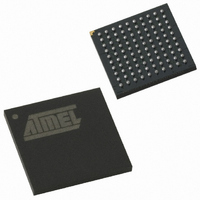AT89C51SND2C-7FTUL Atmel, AT89C51SND2C-7FTUL Datasheet - Page 183

AT89C51SND2C-7FTUL
Manufacturer Part Number
AT89C51SND2C-7FTUL
Description
IC 8051 MCU FLASH 64K MP3 100BGA
Manufacturer
Atmel
Series
89Cr
Datasheet
1.AT89C51SND2C-7FTUL.pdf
(242 pages)
Specifications of AT89C51SND2C-7FTUL
Core Processor
8051
Core Size
8-Bit
Speed
40MHz
Connectivity
I²C, IDE/ATAPI, MMC, SPI, UART/USART, USB
Peripherals
Audio, I²S, MP3, PCM, POR, WDT
Number Of I /o
32
Program Memory Size
64KB (64K x 8)
Program Memory Type
FLASH
Ram Size
2.25K x 8
Voltage - Supply (vcc/vdd)
2.7 V ~ 3.3 V
Data Converters
A/D 2x10b; D/A 2x20b
Oscillator Type
Internal
Operating Temperature
-40°C ~ 85°C
Package / Case
100-TFBGA
Data Bus Width
8 bit
Data Ram Size
2.25 KB
Interface Type
ATAPI, I2S, IDE, SPI, UART, USB
Maximum Clock Frequency
40 MHz
Number Of Programmable I/os
32
Number Of Timers
2
Maximum Operating Temperature
+ 85 C
Mounting Style
SMD/SMT
Minimum Operating Temperature
- 40 C
Lead Free Status / RoHS Status
Lead free / RoHS Compliant
Eeprom Size
-
Lead Free Status / Rohs Status
Details
Other names
AT89C51SND2C7FTUL
Available stocks
Company
Part Number
Manufacturer
Quantity
Price
Company:
Part Number:
AT89C51SND2C-7FTUL
Manufacturer:
ATMEL
Quantity:
4 371
- Current page: 183 of 242
- Download datasheet (3Mb)
21.1.2
21.1.3
4341H–MP3–10/07
Master Transmitter Mode
Master Receiver Mode
Table 21-1.
Note:
In the master transmitter mode, a number of data Bytes are transmitted to a slave receiver (see
Figure 21-3). Before the master transmitter mode can be entered, SSCON must be initialized as
follows:
SSCR2:0 define the serial bit rate (see Table 21-1). SSPE must be set to enable the controller.
SSSTA, SSSTO and SSI must be cleared.
The master transmitter mode may now be entered by setting the SSSTA bit. The TWI logic will
now monitor the TWI bus and generate a START condition as soon as the bus becomes free.
When a START condition is transmitted, the serial interrupt flag (SSI bit in SSCON) is set, and
the status code in SSSTA is 08h. This status must be used to vector to an interrupt routine that
loads SSDAT with the slave address and the data direction bit (SLA+W). The serial interrupt flag
(SSI) must then be cleared before the serial transfer can continue.
When the slave address and the direction bit have been transmitted and an acknowledgment bit
has been received, SSI is set again and a number of status code in SSSTA are possible. There
are 18h, 20h or 38h for the master mode and also 68h, 78h or B0h if the slave mode was
enabled (SSAA = logic 1). The appropriate action to be taken for each of these status code is
detailed in Table 21-2. This scheme is repeated until a STOP condition is transmitted.
SSPE and SSCR2:0 are not affected by the serial transfer and are not referred to in Table 21-2.
After a repeated START condition (state 10h) the controller may switch to the master receiver
mode by loading SSDAT with SLA+R.
In the master receiver mode, a number of data Bytes are received from a slave transmitter (see
Figure 21-4). The transfer is initialized as in the master transmitter mode. When the START con-
dition has been transmitted, the interrupt routine must load SSDAT with the 7 - bit slave address
and the data direction bit (SLA+R). The serial interrupt flag (SSI) must then be cleared before
the serial transfer can continue.
2
0
0
0
0
1
1
1
1
Bit Rate
SSCR2
SSCRx
1
0
0
1
1
0
0
1
1
1. These bit rates are outside of the low speed standard specification limited to 100 kHz but can
0
0
1
0
1
0
1
0
1
be used with high speed TWI components limited to 400 kHz.
Serial Clock Rates
SSPE
0.5 < ⋅ < 125
F
PER
1
200
53.5
62.5
12.5
100
= 6 MHz
47
75
(1)
(1)
SSSTA
0
Bit Frequency (kHz)
0.67 < ⋅ < 166.7
F
PER
133.3
266.7
62.5
71.5
16.5
100
= 8 MHz
83
SSSTO
(1)
(1)
0
(1)
0.81 < ⋅ < 208.3
F
PER
AT8xC51SND2C/MP3B
SSI
104.2
166.7
333.3
78.125
125
20.83
0
= 10 MHz
89.3
(1)
(1)
(1)
(1)
(1)
SSAA
X
96 ⋅ (256 – reload value Timer 1)
F
PER
Bit Rate
SSCR1
Divided By
128
480
112
96
80
60
30
Bit Rate
SSCR0
183
Related parts for AT89C51SND2C-7FTUL
Image
Part Number
Description
Manufacturer
Datasheet
Request
R

Part Number:
Description:
DEV KIT FOR AVR/AVR32
Manufacturer:
Atmel
Datasheet:

Part Number:
Description:
INTERVAL AND WIPE/WASH WIPER CONTROL IC WITH DELAY
Manufacturer:
ATMEL Corporation
Datasheet:

Part Number:
Description:
Low-Voltage Voice-Switched IC for Hands-Free Operation
Manufacturer:
ATMEL Corporation
Datasheet:

Part Number:
Description:
MONOLITHIC INTEGRATED FEATUREPHONE CIRCUIT
Manufacturer:
ATMEL Corporation
Datasheet:

Part Number:
Description:
AM-FM Receiver IC U4255BM-M
Manufacturer:
ATMEL Corporation
Datasheet:

Part Number:
Description:
Monolithic Integrated Feature Phone Circuit
Manufacturer:
ATMEL Corporation
Datasheet:

Part Number:
Description:
Multistandard Video-IF and Quasi Parallel Sound Processing
Manufacturer:
ATMEL Corporation
Datasheet:

Part Number:
Description:
High-performance EE PLD
Manufacturer:
ATMEL Corporation
Datasheet:

Part Number:
Description:
8-bit Flash Microcontroller
Manufacturer:
ATMEL Corporation
Datasheet:

Part Number:
Description:
2-Wire Serial EEPROM
Manufacturer:
ATMEL Corporation
Datasheet:











